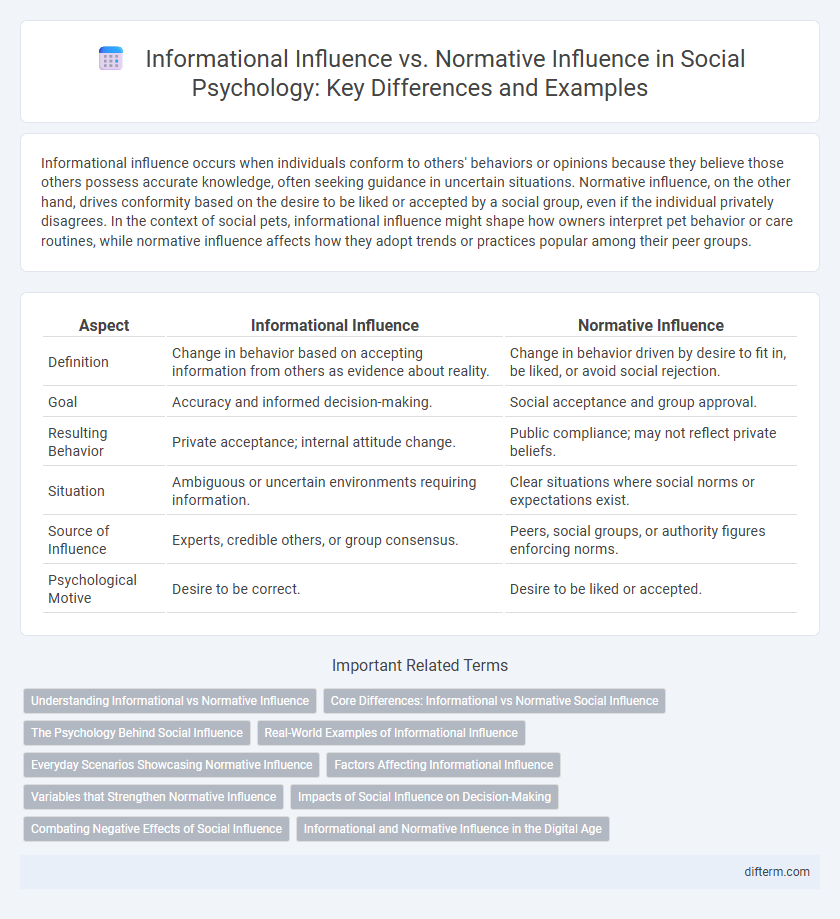Informational influence occurs when individuals conform to others' behaviors or opinions because they believe those others possess accurate knowledge, often seeking guidance in uncertain situations. Normative influence, on the other hand, drives conformity based on the desire to be liked or accepted by a social group, even if the individual privately disagrees. In the context of social pets, informational influence might shape how owners interpret pet behavior or care routines, while normative influence affects how they adopt trends or practices popular among their peer groups.
Table of Comparison
| Aspect | Informational Influence | Normative Influence |
|---|---|---|
| Definition | Change in behavior based on accepting information from others as evidence about reality. | Change in behavior driven by desire to fit in, be liked, or avoid social rejection. |
| Goal | Accuracy and informed decision-making. | Social acceptance and group approval. |
| Resulting Behavior | Private acceptance; internal attitude change. | Public compliance; may not reflect private beliefs. |
| Situation | Ambiguous or uncertain environments requiring information. | Clear situations where social norms or expectations exist. |
| Source of Influence | Experts, credible others, or group consensus. | Peers, social groups, or authority figures enforcing norms. |
| Psychological Motive | Desire to be correct. | Desire to be liked or accepted. |
Understanding Informational vs Normative Influence
Informational influence occurs when individuals conform because they believe others possess accurate knowledge, guiding behavior through a desire for correctness in ambiguous situations. Normative influence arises from the need for social acceptance and fear of rejection, leading individuals to conform to group norms even if they privately disagree. Understanding these influences clarifies how social pressure shapes attitudes and behaviors differently based on the motivation to be right versus the motivation to be liked.
Core Differences: Informational vs Normative Social Influence
Informational social influence occurs when individuals conform to gain accurate information and make correct decisions in ambiguous situations, prioritizing knowledge from others. Normative social influence involves conforming to be accepted or liked by a group, emphasizing social approval and compliance over accuracy. Core differences lie in the motivation behind conformity: informational influence seeks truth, whereas normative influence seeks social acceptance.
The Psychology Behind Social Influence
Informational influence occurs when individuals conform because they believe others possess accurate knowledge, driving behavior through the desire for correct information. Normative influence arises from the need to be accepted and liked by a social group, leading people to conform to avoid social rejection. The psychology behind social influence highlights how cognitive processes and social motivations interact to shape conformity in various contexts.
Real-World Examples of Informational Influence
Informational influence occurs when individuals conform because they believe others possess accurate information, as seen during emergencies when people follow crowd behavior to ensure safety. For instance, during natural disasters, individuals often rely on social cues from neighbors or media updates to make evacuation decisions. Online reviews also demonstrate informational influence, where consumers trust others' experiences to guide purchasing choices.
Everyday Scenarios Showcasing Normative Influence
In everyday social interactions, normative influence is evident when individuals conform to group norms to gain acceptance or avoid social rejection, such as dressing according to workplace dress codes or participating in popular trends among peers. Unlike informational influence, which relies on the desire for accuracy and knowledge, normative influence prioritizes social approval and the maintenance of group harmony. Common scenarios include following community customs, engaging in polite conversation styles, and adhering to unspoken rules within friend circles.
Factors Affecting Informational Influence
Factors affecting informational influence include the perceived expertise and credibility of the source, the ambiguity or complexity of the information, and the level of uncertainty faced by the individual. When individuals encounter novel or unclear situations, they rely more heavily on information from others to form accurate judgments. The presence of confident and knowledgeable sources significantly increases the likelihood of informational influence shaping attitudes and behaviors.
Variables that Strengthen Normative Influence
Variables that strengthen normative influence include group size, unanimity, and cultural tightness, all of which amplify the pressure to conform to social norms. High group cohesiveness and the importance of the group to the individual increase compliance with normative expectations. Enhanced visibility of behavior and social identity salience also contribute to stronger normative influence by heightening awareness of social approval or disapproval.
Impacts of Social Influence on Decision-Making
Informational influence impacts decision-making by leading individuals to accept information from others as evidence about reality, often resulting in more accurate judgments in uncertain situations. Normative influence affects decisions by driving conformity to social norms and expectations to gain social approval, which can sometimes override personal preferences. Both types of social influence shape behavior by altering perceptions of reality and acceptable conduct, significantly affecting group dynamics and individual choices.
Combating Negative Effects of Social Influence
Informational influence, driven by the desire for accuracy, can be countered by promoting critical thinking and fact-checking to reduce misinformation spread. Normative influence, grounded in the need for social acceptance, requires fostering inclusive environments and encouraging individuality to diminish peer pressure impacts. Implementing education programs on social influence mechanisms enhances awareness and resilience against harmful conformity.
Informational and Normative Influence in the Digital Age
Informational influence in the digital age is driven by the overwhelming availability of online data, where individuals rely on accurate information from social media, reviews, and expert content to shape their beliefs and decisions. Normative influence manifests through social media platforms that foster a desire for acceptance, prompting users to conform to trends, opinions, and behaviors endorsed by their digital communities to avoid social rejection. Both types of influence intersect as digital environments simultaneously provide credible information and reinforce social norms, profoundly impacting online behavior and decision-making.
informational influence vs normative influence Infographic

 difterm.com
difterm.com